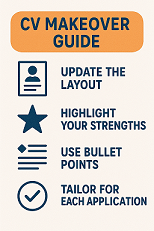A Leading HR Consultancy
"From Ordinary to Outstanding: Your CV Makeover Guide"
CV is your first impression, lets make it magical
Adv. Archana Dubey
7/12/20253 min read
Your CV is often the first impression you make on a potential employer, so it's crucial to make it count. A well-crafted CV can open doors, while a poorly structured one can quickly close them. Here are some key tips that will be your CV makeover guide.
When you send your CV to any company, they judge you by your CV first. Your interview depends on your CV. If your CV is not impressive, they will not call you for a personal interview. In this article, we will help you to makeover your CV from ordinary to outstanding.
Table of Contents
1. Tailor Your CV to Each Application
2. Choose the Right Format
3. Start with a Strong Personal Statement or Summary
4. Quantify Your Achievements
5. Prioritize Clarity and Conciseness
6. Highlight Key Skills
7. Proofread Meticulously
8. Save as a PDF
9. FAQs
10. Conclusion
1. Tailor Your CV to Each Application
There is a common mistake that most job seekers make. One of them is using the same CV for every application. Instead of this, customize your CV for each specific job you apply. Carefully read the job description and identify the keywords, skills, and experiences the employer is looking for. Then, incorporate these into your CV, ensuring your most relevant qualifications are highlighted. Please make over your CV when you need it.
2. Choose the Right Format
While there's no single "perfect" CV format, the chronological format (listing your work experience in reverse chronological order) is the most common and generally preferred. For those with less traditional career paths or significant career gaps, a functional CV (focusing on skills rather than dates) might be an option, but be aware that some employers view these with scepticism. Ensure your chosen format is clean, easy to read, and professional.
3. Start with a Strong Personal Statement or Summary
The days of objective statements are gone. Instead, begin your CV with a concise personal statement or professional summary (3-5 lines) that highlights your key skills, experience, and career aspirations. This acts as an "elevator pitch," immediately telling the recruiter why you're a good fit for the role. You should know the answer to each line if any interviewer asks you about the summary.
4. Quantify Your Achievements
Don't just list your responsibilities; demonstrate your impact. Always use numbers and accurate data to quantify your achievements effectively in every field. Instead of saying "Managed social media," say "Increased social media engagement by 30% in six months." This provides concrete evidence of your capabilities and value.
5. Prioritize Clarity and Conciseness
Recruiters spend mere seconds scanning CVs. Make yours easy to digest by using clear, concise language and bullet points. Avoid jargon, lengthy paragraphs, and unnecessary details. Aim for a CV that is typically one to two pages long; any longer and you risk losing the recruiter's attention.
6. Highlight Key Skills
Create a dedicated "Skills" section where you can list both your hard skills (technical abilities, software proficiency) and soft skills (communication, teamwork, problem-solving). Again, refer to the job description to ensure you're highlighting the skills most relevant to the role.
7. Proofread Meticulously
Always make sure not to make any grammatical mistakes. Sometimes a single grammatical mistake can waste your efforts. Check your CV multiple times and ask someone who can tell you about your mistakes, and review it as well. Use spell-check and grammar tools, but don't rely on them exclusively.
8. Save as a PDF
If you want to makeover your CV, try to save and submit your CV as a PDF file unless otherwise specified. This ensures that your formatting remains consistent across different devices and operating systems, preventing any layout issues that might occur with Word documents.
9. FAQs
Q1. How long should a CV be?
A CV should ideally be 1–2 pages long. Keep it concise and to the point.
Q2. Should I include a photo on my CV?
Unless specifically requested or common in your region, it's usually best to avoid including a photo, as it can lead to unconscious bias.
Q3. Can I send the same CV to multiple companies?
It's not recommended. Always tailor your CV to match the specific job description and company you're applying to.
Q4. What file format should I use for my CV?
Always save your CV as a PDF to preserve formatting, unless otherwise requested by the employer.
Q5. Is it necessary to include references on the CV?
No. Simply writing “References available upon request” is sufficient, or you can omit it entirely unless the employer specifically asks for it.
10. Conclusion
By following these tips, you'll be well on your way to creating a compelling CV that effectively showcases your qualifications and helps you land that all-important interview. Remember, your CV is your personal marketing document—always try to make over your CV.
Your CV is more than just a summary of your experience—it's your brand statement. By applying the right structure, language, and design, you can turn an average CV into a powerful tool that opens doors. Whether you're just starting or aiming for your next big opportunity, a polished and well-crafted CV can set you apart from the competition. So take the time, make the effort, and transform your CV from ordinary to outstanding. Your future self will thank you.


Contact Us here for Inquiries
contact@paratocindia.com
©2025 Paratoc Consulting Pvt Ltd . All rights reserved.
archana@paratoc.co.in
Contact Us for grievance & complaints
ankush@paratoc.co.in
Contact Us for Business Collaborations
Follow us for latest offers
+91-9149183370
Other links (IT Tech. Solutions)
archana@paratoc.co.in
archana@paratoc.co.in
